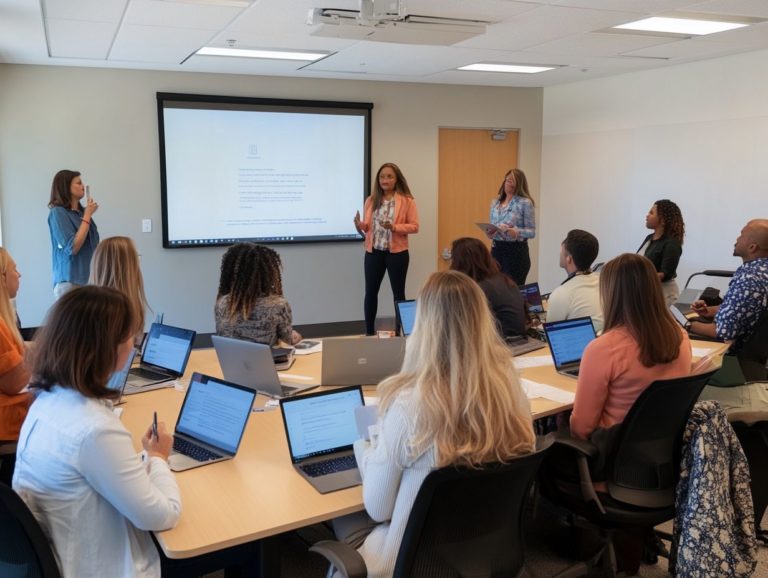How to Measure Skill Enhancement Effectiveness
Skill enhancement boosts your personal and professional growth. It helps you refine your abilities and achieve greater performance.
This exploration delves into the true meaning of skill enhancement. It examines the various factors that influence it and the ways to measure its effectiveness.
Additionally, it presents practical strategies for tracking your progress and offers insightful tips for maximizing your growth journey.
Whether you seek improvement in your career or personal life, grasping these concepts can unlock your full potential, paving the way for unprecedented success.
Contents
- Key Takeaways:
- Understanding Skill Enhancement
- Factors Affecting Skill Enhancement
- Measuring the Effectiveness of Skill Enhancement
- Methods for Tracking Skill Enhancement
- Maximizing the Impact of Skill Enhancement
- Frequently Asked Questions
- What is skill enhancement effectiveness and why is it important to measure?
- What are the different methods for measuring skill enhancement effectiveness?
- How do pre- and post-training assessments measure skill enhancement effectiveness?
- Why is participant feedback important in measuring skill enhancement effectiveness?
- Can skill enhancement effectiveness be measured for all types of skills?
- How can measuring skill enhancement effectiveness benefit organizations?
Key Takeaways:

- Skill enhancement is the process of continuously improving one’s abilities through various external and internal factors.
- You can assess the effectiveness of skill enhancement through key metrics and indicators, such as self-assessment and performance evaluation.
- To maximize the impact of skill enhancement, focus on continued growth and development through self-reflection and seeking feedback.
Understanding Skill Enhancement
Understanding skill enhancement is essential for refining your employee training and development strategies. It requires a complete method that targets specific skills gaps through tailored training programs.
When executed effectively, skill enhancement not only boosts individual performance but also propels overall organizational growth. This ensures that your employees possess the necessary skills to adapt to evolving job demands.
By integrating diverse performance metrics, you can assess the impact of your training initiatives and cultivate a culture of continuous improvement in workplace learning.
What is Skill Enhancement?
Skill enhancement is your pathway to systematically refining your skills and capabilities through targeted training and development initiatives.
You embark on this journey to foster knowledge acquisition, where you’re not just soaking up new information but also learning how to apply it effectively in your field.
By engaging in structured workshops, online courses, and hands-on training, you can significantly boost your performance. This growth can dramatically transform your career!
Organizations reap the rewards too, as they experience a surge in overall efficiency and innovation. This, in turn, nurtures a culture of continuous improvement and adaptability in the workplace, benefiting everyone involved.
Factors Affecting Skill Enhancement
The effectiveness of skill enhancement hinges on a myriad of external and internal factors that intricately shape the training landscape within organizations. Understanding these dynamics is essential for optimizing your approach to professional development.
External Factors

External factors like market trends and technological shifts are crucial in shaping effective training programs.
Internal Factors
Internal elements such as organizational culture and employee engagement also play a significant role. These aspects dictate the content and delivery methods of your training.
They profoundly affect how employees perceive and engage with developmental initiatives. In a rapidly evolving technological landscape, it s essential for organizations to regularly refresh their training materials to remain competitive.
A supportive organizational culture fosters open communication and feedback, boosting employee morale and commitment to learning.
Ultimately, the interplay between these factors crafts an ecosystem where training programs flourish. This leads to increased job satisfaction and enhanced performance across the board.
Start your skill enhancement journey today, and unlock your true potential!
Embrace skill enhancement now, and take the first step towards a brighter future!
Measuring the Effectiveness of Skill Enhancement
Measuring the effectiveness of skill enhancement is essential for ensuring that your training initiatives achieve the desired learning outcomes and align seamlessly with your organizational objectives. Understanding the key metrics for assessing skill enhancement programs not only validates your efforts but also helps refine future programs for maximum impact.
Key Metrics and Indicators
- Employee performance evaluations
- Training effectiveness measurements
are crucial for assessing the impact of your training initiatives. These tools offer a structured approach to gauge how well participants are integrating their newly acquired skills into their roles.
For instance, when you analyze improvements in productivity levels, quality of work, and engagement scores, you can gain significant insights into the overall effectiveness of the training program.
Feedback mechanisms, such as surveys and assessments, give you the power to refine your educational strategies based on participant responses. By concentrating on these specific performance metrics, you can more accurately determine whether your skill enhancement efforts align with the desired outcomes, ensuring that training not only imparts knowledge but also translates into practical, measurable results.
Methods for Tracking Skill Enhancement
Tracking your skill enhancement is easy and rewarding! Consider utilizing self-assessment tools, engaging in feedback surveys, and participating in structured training assessments.
Each of these approaches offers a valuable way to gauge your progress and refine your abilities.
Self-Assessment and Feedback

Self-assessment and employee feedback play pivotal roles in your skill enhancement journey, allowing you to evaluate your progress and pinpoint areas for ongoing improvement.
By engaging in sincere self-reflection, you can gain a clearer understanding of your strengths and weaknesses. This helps you develop a positive approach to learning and nurtures an environment where constructive feedback is welcomed rather than dreaded.
Organizations that prioritize these approaches inspire their workforce to actively seek learning opportunities, leading to improved collaboration and productivity. When you share insights about your development with colleagues, it promotes accountability and reinforces a collective commitment to excellence, highlighting that skill enhancement is a shared endeavor toward achieving organizational success.
Performance Evaluation
Performance evaluations are essential tools for measuring the effectiveness of your skill enhancement initiatives and ensuring successful learning transfer.
These assessments not only shed light on the progress you’ve made after training but also pinpoint areas that may need further development or reinforcement.
When structured effectively, performance evaluations can weave together various training metrics, such as the ability to remember what you’ve learned and real-world application, providing a holistic view of how training influences your overall growth.
These evaluations also encourage ongoing dialogue between you and your managers, fostering a culture of continuous learning and improvement. By understanding this relationship, your organization can better align training efforts with employee performance, ultimately boosting both productivity and job satisfaction.
Maximizing the Impact of Skill Enhancement
To maximize the impact of your skill enhancement, adopt a strategic approach that prioritizes training effectiveness, fosters professional growth, and elevates employee performance.
Start tracking your progress today and unlock your potential!
Tips for Continued Growth and Development
Unlock your team’s full potential! You can achieve continued growth and development by consistently applying training resources and committing to ongoing improvement.
Focus on creating a supportive environment where you and your colleagues feel empowered to enhance your skills and knowledge. Regular feedback methods, like performance reviews and one-on-one sessions, are essential for identifying areas ripe for growth.
Offer diverse training opportunities think workshops, online courses, or mentorship programs to cater to different learning preferences. Encouraging collaboration among team members fosters innovation and the exchange of fresh ideas, propelling your organization toward its goals.
By prioritizing these strategies, you can cultivate a culture that values ongoing employee development and adapts seamlessly to changing industry demands.
Frequently Asked Questions
What is skill enhancement effectiveness and why is it important to measure?
Skill enhancement effectiveness refers to the degree to which a training or development program has improved an individual’s skills. Understanding the challenges of skill enhancement is important to measure the impact of the program and make necessary improvements for future training initiatives.
What are the different methods for measuring skill enhancement effectiveness?
Some common methods for measuring skill enhancement effectiveness include:
- Pre- and post-training assessments
- Surveys and feedback from participants
- Observations of performance in real-life situations
How do pre- and post-training assessments measure skill enhancement effectiveness?
Pre- and post-training assessments involve evaluating an individual’s skills before and after completing a training program. The difference between the two scores indicates how much the program has enhanced their skills.
Why is participant feedback important in measuring skill enhancement effectiveness?
Participant feedback provides valuable insight into the effectiveness of a training program. It allows for understanding what aspects of the program were successful and what areas may need improvement.
Can skill enhancement effectiveness be measured for all types of skills?
Yes, skill enhancement effectiveness can be measured for both hard and soft skills. Hard skills are technical skills that can be clearly measured, while soft skills relate to how well people work with others.
How can measuring skill enhancement effectiveness benefit organizations?
Measuring skill enhancement effectiveness can help organizations make informed decisions about future training and development initiatives. For more insights, consider exploring the best practices for skill enhancement programs, which can also demonstrate the return on investment for training programs and aid in identifying areas for improvement within the organization.







